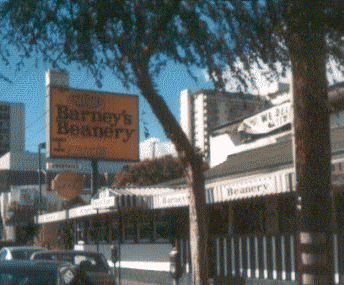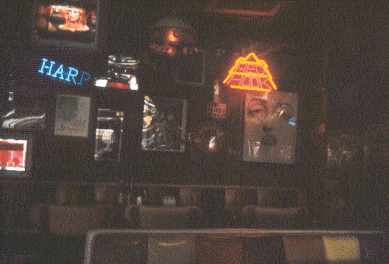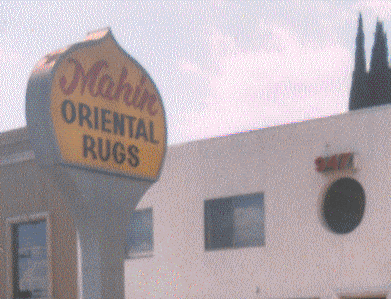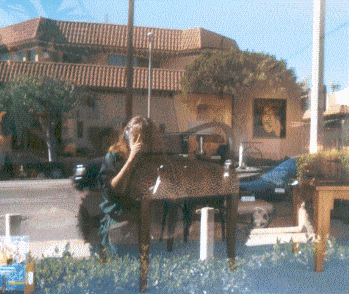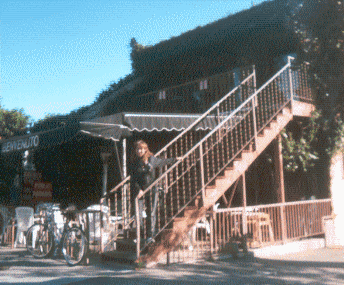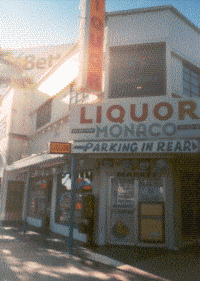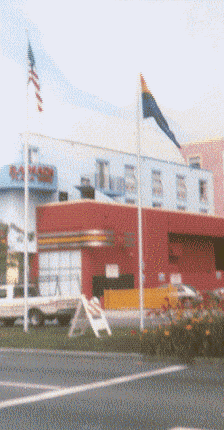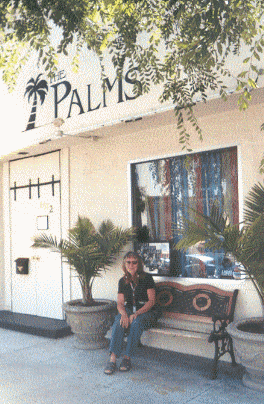 | Jim Morrison of The Doors was a real talent. A leader, a visionary and a poet, Jim was an original. The music and poetry he created with The Doors is truly above and beyond. |
|
"Цветы Лео" (8505 Бульвар Санта-Моники). Во время The Doors здесь был переговорный пункт с телефонами-автоматами и внешний бар, место, где The Doors любили ошиваться. В одной изсцен фильма HWY неоновый свет прежнего Телефона-автомата легко опознаваем |
Barney''s Beanery (8447 Santa Monica Blvd)Джим любил звтракать в Barney''s Beanery (8447 Santa Monica Blvd). Здесь вы можете сыграть раунд pool или billard, что и делали члены The Doors. Один взгляд на бар показывает нам и другие любимое место Джима. Он имел обыкновение проводить многочисленные ночи в этой узкой комнате в компании Малыша Хилла, Франка Лискиандро и многих других. Это также одна из сцен для фильма Оливера Стоуна "Двери". В ресторане Джим Моррисон имел обыкновение есть печень цыпленка с луком.. |
Barney''s Beanery inside. Столовка Берние знаменита не только тем, что Джим Моррисон здесь регулярно завтракал куриной печенкой, которую и сегодня можно заказать и можно было заказать 75 лет назад, когда харчевня основана. Бернье прославилась тем, что локализуясь в месте поселения гомосексуалистов, осталась главным плацдармом антигомосексуалистов. |
|
(947 La Cienega Boulevard). - здание с доской объявлений "Mahin Oriental Rugs" (947 La Cienega Blvrd) - бутик Памелы Courson, который финансировал Моррисон и который она держала 3 года. Вверх по лестнице - расписная дверь. За дверью - шоссе (HWY). Этот офис Джим арендовал для работы над фильмом " HWY" вместе с Франком Лискиандро |
Здание испанского стиля сегодня принадлежит Ohlmeyer Communications Company (962 La Cienega Blvrd). Это бывшая Elektra Sound Recorders Studio, где Двери записали альбом "Мягкий Парад" и "Morrison Отель" - 962 La Cienega Boulevard) |
(8513 Бульвар Санта-Моники) - магазин Monaco Liquor, место, где Двери покупали напитки для репетиции. Джим Морризон покупал алкоголь только здесь,в двух шагах от мотеля и Офиса The Doors |
|
(8513 Бульвар Санта-Моники) - магазин Monaco Liquor, место, где Двери покупали напитки для репетиции. Джим Морризон покупал алкоголь только здесь,в двух шагах от мотеля и Офиса The Doors. |
Santa Monica Boulevard- an arch-like block of flats in the shape of a horse shoe called "New Orleans Square". Only a few years ago the Tropicana Motel as well as Duke''s Coffee Shop were situated in this building complex(8585 Santa Monica Boulevard). |
The Palms (8572 Santa Monica Boulevard). |
Los Angeles is the city of The Doors, and The Doors are and remain inseparably linked to Los Angeles. Doors fans who get involved in the "Los Angeles Adventure" and spend two afternoons on the search for historic Doors places with the help of this guide, may soon find out why this city is so important to the group; and they will feel Jim Morrison''s vibes more or less at every other corner. With the song "L.A.Woman" Jim immortalised this city. Ray Manzarek, John Densmore and Robby Krieger are still living here. Understandably, I cannot give their private addresses in this context
For long years West Hollywood used to be the centre of The Doors. Every Doors tourist should logically start his expedition here; besides, all the Doors sights are in walking distance and all can be seen within two hours
Let us begin with a nice breakfast at Barney''s Beanery (8447 Santa Monica Boulevard). If you fancy, you can play a round of pool or billard, like The Doors often used to do. One look into the bar shows us another one of Jim''s favourite places. He used to spend numerous nights in this narrow, tubeshaped room in the company of Babe Hill, Frank Lisciandro and many others. This is also where one scene for Oliver Stone''s film "The Doors" was shot. In the restaurant Jim Morrison used to eat chicken liver with onions. When you order it you will get a gigantic portion including salad for a reasonable price
Let us leave Barney''s Beanery and walk across the street, follow Santa Monica Boulevard on the righthand side and stop at the next street corner. On the other side of the road you can see "Al & Ed''s Autosound". In Morrison''s time it used to be called The Extension, a topless bar with a dancefloor, where Jim liked to meet with journalists. He had been amused by the fact that the reporters would be distracted and confused by the waitresses and dancing girls. The famous "Rolling Stone"-interview with Jerry Hopkins was done in t
Let us walk a little bit on the lefthand side down La Cienega Boulevard. We come across a Spanish-style building, which today belongs to the Ohlmeyer Communications Company (962 La Cienega Boulevard). In earlier times the Elektra Sound Recorders Studio used to be situated here, where The Doors recorded the albums "The Soft Parade" and "Morrison Hotel". Direct entry to the studio was through the dark brown wooden door adjacent to the main building
Crossing the street, the way leads directly to a one-storey building with a yellow billboard attached to it saying "Mahin Oriental Rugs" (947 La Cienega Boulevard). The room next to the entrance door, both decorated with iron bars, is where Pamela Courson''s boutique Themis used to be, which Jim Morrison had financed for her and which she had run for about 3 years. Walking up the stairs behind the front door, one will get to a balustrade which leads directly to a door with the letter K. Behind this door the HWY Office used to be situated, which Jim Morrison had rented in order to prepare and process his film HWY, together with Frank Lisciandro and other co-workers
Let us again walk down La Cienega Boulevard up to the "Al & Ed''s Autosound" and turn left into Santa Monica Boulevard. After a few yards one will see a boxshaped red building on the left. Today it is called the Benvenuto Cafe. Before this was called "The Center" and served as the office of a gay & lesbian community centre. Up until 1972 it was painted yellow, had a different type of staircase and was the Doors Office (8512 Santa Monica Boulevard). This is where The Doors and Bill Siddons did their paperwork; this is where Kathy Lisciandro worked as Jim Morrison''s secretary; this is where Danny Sugarman answered the fan mail. The group''s rehearsal room was situated on the lower floor, where the sessions and recordings for the album "L.A.Woman" took place between October 1970 and February 1971. After The Doors moved out in 1972, the building remained a sound studio and was called "The Upside Down Studio" until 1985. After renovation of the staircase the gay & lesbian community centre moved in
Walking a little further up Santa Monica Boulevard, one will discover a bar called The Palms (8572 Santa Monica Boulevard). Jim Morrison had sat inside this bar numerous times, used to take a little snack here and drank beer and whiskey during the breaks between rehearsals
We are now crossing Santa Monica Boulevard and follow the road down towards the left. Soon we arrive at the Troubadour (9081 Santa Monica Boulevard). This is the club where Jim saw the comeback of the Smothers Brothers. After a booze-up with Babe Hill, Jim Morrison was barred from this club. It is the same club where once upon a time John Lennon and Harry Nilsson got totally drunk and ended up being kicked out. Today the Troubadour exclusively presents Punk and Heavy Metal bands
Let us turn right again, walking back down Santa Monica Boulevard, and after a few steps we reach an arch-like block of flats in the shape of a horse shoe called "New Orleans Square". Only a few years ago the Tropicana Motel as well as Duke''s Coffee Shop were situated in this building complex (8585 Santa Monica Boulevard). Between 1966 and 1969 Jim used to live in this motel, with a few short interruptions. He regularly used to have breakfast at Duke''s Coffee Shop. The Tropicana Motel was dissolved, and Duke''s Coffee Shop moved into the same building as the Whiskey A GoGo
Only a few yards further, at the junction of Santa Monica Boulevard/La Cienega Boulevard, is a supermarket called Monaco Liquor (8513 Santa Monica Boulevard). This is where The Doors used to buy their drink supplies during rehearsal breaks. Jim Morrison used to exclusively purchase his alcohol here, as the supermarket was only a minute away from Jim''s motel room and the Doors Office. The exterior of the supermarket has since then hardly changed
A few further steps lead to a dark brick building, in which the florist "Leo''s Flowers" resides today (8505 Santa Monica Boulevard). At the time of The Doors this place used to be the Phone Booth, another topless bar where The Doors liked to hang out. In one scene of HWY the neonlights of the former Phone Booth are easily recognised
Directly adjacent to "Leo''s Flowers", at # 1005 La Cienega Boulevard, is the Alta Cienega Motel. This is where Jim Morrison lived, with short interruptions, on the second floor, room No. 32, between 1968 and 1970. His window is situated directly above the driveway.
No one wanted to break on through more than Jim Morrison. Yet when the opportunity finally presented itself, the Electric Poet got cold feet. Nevertheless, he persevered and finally did jump over to the other side in Dutch writer Ineke Verheul''s new book The Tenth Life of Jim Morrison.
This book is a fictional odyssey of Morrison''s post-death adventures deep in the heart of Paris. The story begins when Morrison awakens in some kind of weird fog of nothingness, unsure of how he had gotten there. He sees a woman kneeling in the dirt; believing it to be Patricia (Kennealy, although the author doesn''t use her last name), he cries out. She doesn''t respond. Morrison begins to wonder if he is indeed dead, though he subsequently discards the idea. Paris seems too lively for that.
Employing the oft-used stranger-at-the-gate technique, Verheul next introduces the character of David, a young boy who seemingly functions as Morrison''s post-humous guardian angel. David takes the now homeless, and somewhat truculent, rock star to meet a mysterious elderly Indian, known only as Mr. Jones. While Morrison reluctantly convalesces at the Indian''s home, he endures a series of bizarre dreams and adventures that reflect upon and analyze selected segments of his life.
The first dream begins amid the pre-Miami fight with girlfriend Pamela Courson and proceeds through the disastrous Florida performance and the ill-fated trip to Jamaica. Morrison finds himself on the beach having a curious and poignant conversation with John Densmore, during which the latter reveals his ambivalent feelings about the singer. Densmore just could not understand Morrison''s self-destructiveness and doesn''t want further explanations at his point. Morrison descends into fury as the dream ends, and he wakes up in a sweat, still at Mr. Jones'' home.
The next morning Morrison decides to visit his friend Agnes (Varda). Although the latter is unavailable, another woman in the apartment lets him in. Jim wonders if she might be Marianne Faithful. She hotly denies this; Morrison learns later that she calls herself Kundry. They end up at a bar and meet two other women. A myriad of complexities ensue in what is arguably the most inscrutable scene in the book. Morrison manages to escape unscathed, only to find himself deep in some dark place gazing longingly upon a group of vagrants steeped in some form of mysterious brotherhood. Morrison finds them intriguing, yet the boy David suddenly appears saying, "You''re not ready." He then convinces Morrison to return with him to the old Indian''s house.
Morrison has another dream that night, this one as chaotic and confusing as the first. Basically a summary of his bitter pregnancy entanglement with Patricia Kennealy, this dream ends with tears of grief for what was not to be.
The book includes numerous and lengthy conversations between Morrison and David. In one such discourse, the former tries to explain his fascination with reptiles and the genesis of the title Lizard King. David suggests in so many words that Morrison craves the spotlight, as it were. Their conversation shifts to their respective disappointments in film and writing; both have been rejected for past efforts.
By this time Morrison wants to recover his lost identity. They decide to visit the consulate in hopes of replacing his lost papers. The escapade is a disaster; the authorities call Morrison an impostor. They flee to a coffee shop where David decides to give Morrison a gentle push toward the truth.
"Would you believe me if I showed you your grave?"
He takes him to the grave, and Morrison goes into shock. A little later he has the last dream.
This one is about his childhood. During a frightening thunderstorm, the young sleepless boy seeks shelter in his mother''s bed. She allows him to stay; he drifts off and dreams that he and his mother are naked together. His mother rebuffs him in horror. He fears terrible consequences when his father finds out.
Morrison again awakens to the presence of David and Mr. Jones, snarling and snapping like a sea turtle. Eventually the old man turns to David. "Do you think he''s ready?" The latter acquiesces, and it''s time for the final adventure.
They observe the group of vagrants Morrison had seen previously. This time, the men sit in a circle. David and the Indian join them first. David then beckons, and Morrison joins the group. It seems that they are watching a movie, one in which he himself stars.
This is the final Morrison film, the one telling the story about the end of his days. For it also stars Pamela Courson and some lines of white powder. We have all heard the ending. As the picture ends, Morrison joins hands with the others, on the other side at last.
The Tenth Life of Jim Morrison is not for sissies. It takes concentrated effort to comprehend the subtle nuances of both the characters and plot. In fact this is a character study more than a story per se, as the book tends to focus mainly on dreams and dialogue. Nevertheless, Verheul makes a serious attempt to get inside the mind of Jim Morrison, to understand his relationships with his girlfriends, the other Doors, his parents, and authority in general. She largely succeeds in most respects, although more introspection into his actual poems and songs would elevate the book a bit, which tends to sometimes bog down in fights with girlfriends.
Still, this is a very creditable and highly readable attempt to find the man behind the myth, behind the movie, and behind the music, as Morrison reaches the other side at last.

